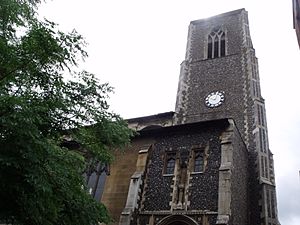St Andrew's Church, Norwich facts for kids
Quick facts for kids St Andrew's Church, Norwich |
|
|---|---|

St Andrew's Church, Norwich
|
|
| 52°37′49″N 1°17′43″E / 52.63028°N 1.29528°E | |
| OS grid reference | TG 23109 08716 |
| Location | Norwich, Norfolk |
| Country | England |
| Denomination | Church of England |
| Churchmanship | Evangelical |
| History | |
| Dedication | St Andrew |
| Architecture | |
| Heritage designation | Grade I listed |
| Administration | |
| Parish | St Andrew's Norwich |
| Deanery | Norwich East |
| Archdeaconry | Norwich |
| Diocese | Anglican Diocese of Norwich |
| Province | Province of Canterbury |
St Andrew's Church in Norwich is a very old and important building. It is a Grade I listed medieval church, which means it's super special and protected because of its history and architecture. It's one of the largest and last medieval churches built in the city.
Contents
Discovering St Andrew's Church
St Andrew's is a great example of a hall church. This means its main parts, like the nave (where people sit) and the aisles (the side sections), are all about the same height. It was built in the late Perpendicular Gothic style, which is a type of architecture popular in England during the late Middle Ages. You can see this style in its tall windows and straight lines.
The main part of the church was built between 1499 and 1518. The tall tower was finished around 1498. The south porch, which is an entrance area, dates back to about 1469, and the north porch to about 1474.
A Look Back in Time
After the Reformation, a big change in religion in England, St Andrew's became a place for the new Protestant faith. In August 1603, a pastor named John Robinson became a leader at the church. Norwich had strong connections with countries like Holland and Flanders back then. Many foreign workers and refugees lived there, and some important leaders were Puritans, who wanted to make the church simpler.
John Robinson was one of the people who helped start the Congregational church. He later became a pastor for the Pilgrim Fathers. These were the people who traveled to the New World (America) to find religious freedom.
Important Dates in History
Here are some key moments in the church's long history:
- 1386: People started leaving money in their wills to a church that was on this very spot.
- 1478: The west tower of the church was being built.
- c.1496: Work on the west tower was completed.
- 1506: The main parts of the church, the nave and chancel, were finished. They replaced an older building.
- 1557: Elizabeth Cooper, a pewterer's wife, was sadly burned as a heretic. This event is mentioned in Foxe's Book of Martyrs.
- 1607: The churchwardens (people who look after the church) were removed from the church for putting in special seats for important local people.
- 1637: A special cover for the font (a basin used for baptisms) was made.
- 1867: The church had a big restoration. This included new pews (church benches), a new pulpit (where sermons are given), and a stone screen.
- 1878: The font was replaced with a new one.
- 1905: The organ case, which holds the church organ, was put in place.

Honoring Important People
Inside St Andrew's Church, you can find monuments that remember many important people from history. These include:
- Robert Suckling (died 1589)
- Francis Rugge (died 1607)
- Robert Garsett (died 1613)
- Sir John Suckling (died 1627)
- Joseph Ellis, a minister (died 1694), who has a monument with a coat of arms showing three eels.
- Dr. Thomas Crowe (died 1751), whose monument was made by Robert Page.
- John Custance (died 1752), whose monument was made by Thomas Rawlins.
- Hambleton Custance (died 1757), also by Thomas Rawlins.
- Richard Dennison (died 1768), also by Thomas Rawlins.
Also buried at the church are Arthur Haselwood II, a silversmith, and his wife, Elizabeth, who was also a silversmith.
The Church Organ
The very first organ in St Andrew's Church was put in back in 1808. This organ was made by G.P. England and had been used before in a place called the Assembly House.
The organ you see in the church today was installed in 1905. It was made by a company called Norman and Beard. Later, in 1919, their successor company, Hill, Norman & Beard, added more pipes and a special part called a swell sub-octave coupler. A coupler connects different parts of the organ so more sounds can be played at once. They rebuilt the organ again in 1980. The beautiful wooden case that holds the organ was also installed in 1905. You can find more details about this organ on the National Pipe Organ Register.


